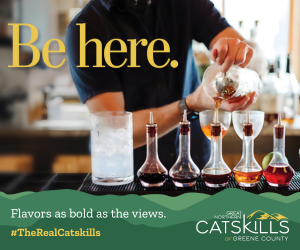Not quite a red, and not exactly a white, rosé wines seem to be one of the most misunderstood wines in the United States. Fortunately there has been a slow but profound change in American attitudes towards rosé wines, and the Hudson Valley’s wineries are well ahead of the curve.
Rosé is the French word for rose-colored, the color pink, and of course, rose-colored wines. Rosés, as the wines are known, owe their color to the fact that they are neither fermented entirely with the grape skins, like all red wines, nor fermented entirely without the skins, as is the case with white wines. These wines have a wide range of colors from blush with tangerine, to coral glass, salmon pink to electric pink, and peppermint to cherry. A rosé wine can range from dry to semi-dry to sweet, and from still to frizzante to sparkling. Rosés serve well as a stand-alone aperitif, are thirst quenching, and are ideal with a summer meal. Like white wines, they are often served chilled, and as they are not made to age long, they are often drunk while young, crisp and fresh.
In Europe, there are certain regions that specialize solely in the production of rosé wines, such as the Anjou-Saumur (Loire Valley); Côtes de Provence; Marsannay and Beaujolais (Burgundy); Tavel (Rhône Valley); northern Alsace and Pineau des Charentes (Cognac). In Portugal, Mateus and Lancers are large producers of rosé, or rosado, as it is known. A wide variety of grape varieties are used in Europe for rosé wines, including Grenache, Pinot Noir, Cabernet Sauvignon, Cabernet Franc, Cinsault, Gamay Noir, Grolleau Noir and Chambourcin.
Europeans have always treated their rosés with respect. The British wine writer, Hugh Johnson, author of Wine: A Life Uncorked, suggests that, “while rosés have no long pedigree, and need no special serving etiquette, they are an all-purpose wine for thirsty people. It is a useful wine that can be a solid fallback wine at any time. They are simple wines that are refreshing and go well with many types of food throughout the year. Rosé reigns supreme at the informal lunch, picnics and kitchen parties. They are often categorized as specialty wines that are consumed by those few who truly appreciate their qualities.”
Unfortunately, in the U.S., unlike in Europe, the production of rosé is generally an afterthought to the production of other still or dessert wines. Here, sadly, rosés have the reputation of not possessing the cachet of a serious red or white wine. Rosé wines are not often mentioned in American survey wine books, and continue to be underrated by many wine drinkers. For instance, in the monumental wine text, The Wines of America, by the noted Leon D. Adams, there is little or no mention of rosé wines at all.
Generally speaking, most rosés are easy-going, light and fresh quaffable wines that possess a soft balance of fruit, acidity and alcohol. The flavor profiles range from red berries like raspberry or cherry, to other fruits such as pomegranates, strawberries, watermelons or peaches. Aromas can be fruity like red or black berries, and fragrant like rose petals, violets and other flowers. They are versatile and fun, with the ability to pair well with many different types and styles of food.
FIFTY SHADES OF ROSÉ
Most wineries in the Hudson Valley produce a rosé. The wines vary from sweet to dry; some are aged in stainless steel, others in oak barrels, but all are worth a serious try.
It is wrong to think that all rosé wines are simple, or lesser quality drinkable wines that cannot be taken seriously. They can be made into quality, firm, but bright, wines of great elegance. Some of the most well-known French rosés such as Cabernet d’Anjou, Cabernet de Saumur, and Rosé d’Anjou from the Loire Valley, and Rosé des Riceys in the south Champagne region, are sometimes oak-aged. They are firm with a steely finish, but possess the fruit of raspberries, red currants, pomegranates, and apricots that can stand up to the wine’s high acids.
There are two classic ways to vinify a rosé wine. One way is to ferment crushed red grapes on the skins (maceration) for a very short period of time of no more than four to twelve hours. Another popular method called saignée, or bleeding, is sometimes used. For this process, a winemaker removes some of the juice during primary fermentation for red wine. The “pink” juice is then fermented separately to create a rosé. In both cases, the process extracts some of the color and tannins from the red grape skins, but still leaves the overall flavor profile and acid balance of an acidic fruity white. These rose-colored wines can be fermented dry to make a fruity dry wine, or left with some sugar to produce a semi-dry to semi-sweet wine. The wines can then be aged in stainless steel or glass so that they retain their bright, fruity flavor profile. When made as a semi-dry wine, the sugar masks the high tartaric and malic acids so that the wine tastes soft, round and approachable.
To add complexity, some dry rosé wines are barrel aged to give them more character. When made in this fashion, they are truly neither a red nor a white wine – they are something completely different. These barrel-aged rosés have much more complexity, nuance and tannic structure that can stand up to their big and bright fruit, from the nose to the finish.
Rosés can be very different in taste based on the grape varieties used. In the Hudson Valley, rosé wines are being made with both French-American grape varieties, such as Baco Noir, Cascade, Chambourcin and Chelois, as well as native labrusca grape varieties such as Concord, Catawba, Delaware, and Iona. The latter are known as pink labrusca, or “Pink Cats”, and are fermented for only a short period of time. These labrusca rosés taste more like fruit wines that have a grapey, musky taste with spicy undertones, but with a soft grapiness (unlike Concord, which is a much harsher wine). They have a significant presence and are very fruit-forward and perfumey in the nose and taste, with notes of strawberries, guava, pineapples, cherry bubblegum and tutti frutti, but there is an underlying presence of spice. Even if finished sweet, these wines have a firm acid structure with a long, clean enjoyable finish. Examples of this style include Warwick Valley Winery’s Black Dirt Blush, Palaia Vineyards’ Joyful Pink, and Hudson-Chatham Winery’s Ghent Blush.
Rosés made with French-American hybrid grapes, such as Baco Noir, Burdin Noir, Cascade and Chancellor, taste more like traditional, European-style rosés. They tend to be more subtle in flavor when compared to the labrusca-based “Pink Cats”, but are generally more flavorful than their French counterparts, which can be very light in taste and acid balance. Rosés made in the Hudson Valley have a more integrated nose of rose petals and violets, with fruits of light strawberry, raspberry, cranberry, watermelon and cherry flavors that carry through to the finish. In addition, these wines have more acid to back up the wine’s fruit, hence they tend to be finished semi-dry to balance their high acids.
A third, more controversial way to make a rosé is by blending—adding a small percentage of red wine (no more than five to ten percent) to a white wine. The process is outlawed in Europe and in France (except the Champagne region), but allowed in the U.S. When this method is used, the rosés tend to be more like a pink white wine, in that they usually don’t have the soft integrated tannins found in those fermented on red skins for a short period of time. However, they can still be versatile wines that go well with many types of food. They can also be made dry, semi-dry or semi-sweet. The flavor profile of these wines is similar to the labrusca and French-American varietal-based wines.
While rosé wines in the U.S. have often been overlooked these past few decades – the White Zinfandel craze which flooded the market didn’t help – consumers are finally beginning to realize that these wines are not the sweet wines of old, but sophisticated wines made from popular varietals. Rosé wine sales are seemingly on the rise, and the Hudson Valley is producing its fair share. Check with your local wine shop, or better yet, visit a Hudson Valley winery. There’s never been a better time to discover the allure of these rose-colored classics.
AND THEN THERE WAS BLUSH…
Blush wines are another popular type of rosé. These wines are fruity in taste, with a pleasingly bright, light salmon color, and generally a shade lighter than a conventional rosé. The origin of blush wines, though, is unconventional, and dates back to the California white wine boom of the late 1970s. The rise in popularity of pink California wines back then, particularly White Zinfandel, necessitated the need for a more generic term other than rosé, especially when a varietal was not indicated on the label.
“Blush” ultimately became that term, and was first used by Mill Creek Vineyards of Sonoma, in 1977. According to popular legend, when owner Charles Kreck tried to make a white wine from their Cabernet Sauvignon grapes, the white juice picked up a golden, reddish tinge, yet wasn’t quite “pink” enough to be sold as a rosé. Wine writer Jerry Mead, who happened to be present at the tasting, suggested they name it “Cabernet Blush.” They did, and the rest, as they say, is history. Thus “Blush” entered the American lexicon and became the nouveau term for light pink wines, an alternative for the rosé appellation. Legend also notes that Kreck was able to trademark the word “Blush” and charge a fee to other wineries who use the term on their labels.
On the east coast, an early blush was made in response to Hurricane Gloria which hit New England in September 1985. The hurricane decimated the vineyards at Sakonnet Vineyards, in Rhode Island, around harvest time. In an attempt to salvage their crop, Sakonnet Vineyards blended all of their remaining battered grapes, mostly Vidal Blanc and Chancellor, into one light, salmon-colored wine called “Eye of the Storm,” which featured a satellite weather picture of Hurricane Gloria on its label. The wine proved so popular that to this day, Sakonnet Vineyards continues to produce this blush wine.





